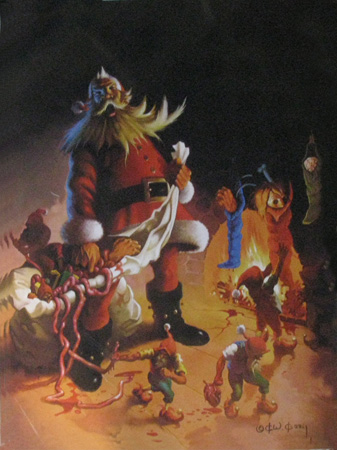 The Coming of the Horseclans
The Coming of the Horseclans by
Franklin Robert Adams
S.E.Lindberg rating:
4 of 5 stars;
View all his reviews
Fans of military fantasy with Sword & Sorcery traits will enjoy this (David Gemmell and Karl Wagner were better writers, but fans of theirs would enjoy this opener of the Horseclans series). The premise is ostensibly apocalyptic sci-fi, but really it appears as a gritty epic fantasy (i.e. no bullets or lasers or machines, just barbarian hordes, swords and some mutant-telepathy and immortality mixed in).
Cover artist
Ken Kelly did a superb job, and arguably was more successful than the author in presenting/creating the world. Truthfully, it is worth tracking these out of print books down just for the cover art. It is an interesting opening book, and since I am compelled to read the next book (Swords of the Horesclans) I rate it 4/5.
 Swords of the Horseclans
Swords of the Horseclans by
Franklin Robert Adams
S.E.Lindberg rating:
3 of 5 stars ;
View all his reviews
Epic in scope. A little less gritty than the the first in the series (Coming of the Horseclans), which featured gore, rape, and torture. Instead, the comical plight of Demetrios offers some levity. The logistics of battle are articulated nicely. The dialogue style is unnatural, however; essentially the dialogue is just more narrative from the author rather than genuine conversation. The primary battle is largely anticlimactic since we are constantly
made aware that the antagonist army is uninspired and ill-prepared.
I admit to being enthralled by
Ken Kelly's cover art. Compared to the text, the cover art disproportionally brings to life the post-apocalyptic North America "Horseclan" world. I am compelled to read the next in the series, though I am expecting less than after reading the first book.
 Revenge of the Horseclans
Revenge of the Horseclans by
Robert Martin Adams
S.E.Lindberg rating:
4 of 5 stars;
View all his reviews
Inappropriately named “Revenge” (this nice read had little to do with Horseclans seeking revenge) this introduces the Kindred leader Bili as he assumes power of his clan after his ruling father’s death (the “Bili the Ax” title was reserved for installment#10 but would have made more sense here); again
Ken Kelly’s covers seem to represent the book disproportionally… since at least it focuses on Bili and his Axe. This epic fantasy is plagued with some cheesy dialogue, but it is forgivable since the story develops nicely.
This installment continues to develop the Horseclan world at a nice pace while reinforcing the role of telepathy, Kindred Law, and the conflict between: (a) barbarian hordes, vs. (b) sensationalized-greek-religiosity vs. (c) lurking science-derived-warlocks. Bili is set up to have key roles under the Undying god Milo’s leadership.
 A Cat of Silvery Hue
A Cat of Silvery Hue by
Robert Adams
S.E. Lindberg rating:
3 of 5 stars
This fourth installment continues Robert Adams' dense narrative. The antagonists are portrayed as "Christians turned crazed homosexuals bent on human sacrifice." Bili and Milo continue the quenching of the rebellion (which is still left unresolved...in mid-battle no less).
Disappointingly, the main characters consume the spotlight but do not perform much with their powers other than mindspeak (telepathy). A Cat of Silvery Hue really is about the average Geros, who rises to the occasion to perform heroic deeds that hundreds of nearby veteran warriors fail to address. Geros exhibits more "character" than any of the main characters, and the title is named in honor of his exploits. However, he is a marginal character whose presence is sparse.
I am left with the same feeling I get when I order a greasy hamburger to-go from a fast food joint, leave the drive though, and discover that I was given a chicken sandwich by mistake. I'll curse the restaurant, claim I will never come back, but will anyway after some time.
+ Geros is developed nicely
+ The fight scenes deliver as expected.
+ The Horseclans is very much like fast food.
- The main characters did not develop or perform exciting roles
- All the bad guys are blundering idiots with the exception of Drehkos
- Occasional erotica scenes are out-of-place and laughable
- The Horseclans is very much like fast food.
View all my reviews

 Rathen, a former Captain in King Delvant’s army, retired to a quiet backwater town after the Kingdom’s forces were dissolved following the King’s sudden death. Trying to forget his problems by the copious use of strong ale, he is approached by the emissaries of a powerful lord to lead a team of fighters, healers and mages to dispel brigands from his lands. Rathen quickly recruits his best friend, an ex-gladiator and landlord of the local tavern, Bulo, to assist him. The two join other members of the group and begin to hear stories of magical creatures and numerous dead in the land they are supposed to cleanse. Despite this, they head for Ghrakus Castle and on the way they learn of the Castle’s dark and mysterious history.
Rathen, a former Captain in King Delvant’s army, retired to a quiet backwater town after the Kingdom’s forces were dissolved following the King’s sudden death. Trying to forget his problems by the copious use of strong ale, he is approached by the emissaries of a powerful lord to lead a team of fighters, healers and mages to dispel brigands from his lands. Rathen quickly recruits his best friend, an ex-gladiator and landlord of the local tavern, Bulo, to assist him. The two join other members of the group and begin to hear stories of magical creatures and numerous dead in the land they are supposed to cleanse. Despite this, they head for Ghrakus Castle and on the way they learn of the Castle’s dark and mysterious history.

































